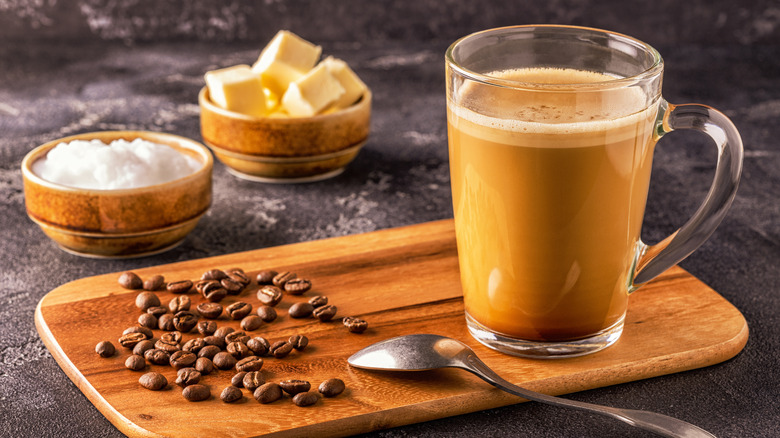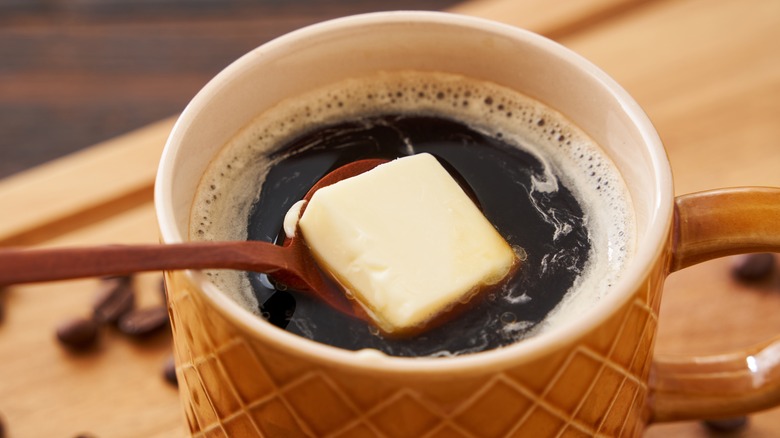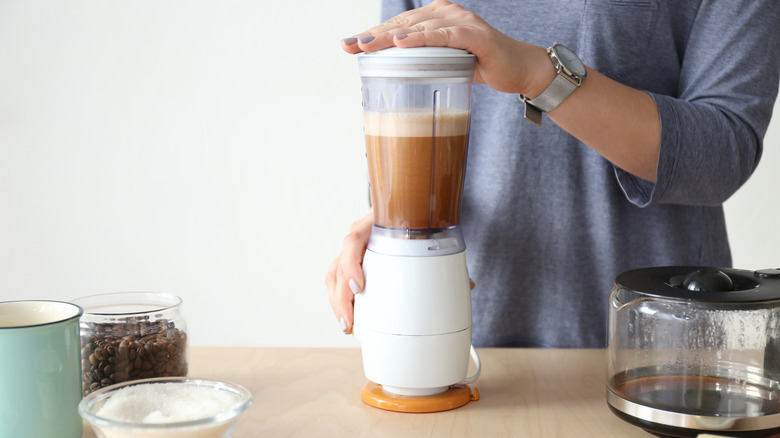The Reason People Put Butter In Their Coffee
If you thought butter coffee was a trend that got left behind in the low-carb craze of the early 2000s, you're mistaken. People are still blending butter with all types of coffee to create rich, frothy beverages, like TikTok creator @ryantagcoffee who added it to espresso, and YouTuber @bell.annabell, who stirred it into a cup of hot coffee. Many butter coffee fans swear by the drink's health benefits, reporting that it promotes weight loss and mental clarity. But like viral butter candles, butter coffee tends to stir up controversy too.
Butter coffee isn't new — variants of it have been enjoyed around the world for ages, including in places like Singapore, Northern India, Ethiopia, Tibet, and Vietnam. However, this drink gained traction in the U.S. around 2009. Legend has it this was the year entrepreneur Dave Asprey created the recipe for Bulletproof coffee (unsalted grass-fed butter, MCT oil, and coffee), inspired by a trip to Tibet where he encountered a caffeinated drink blended with yak butter. Asprey's recipe and the products on the Bulletproof website promise not just a rich, creamy drink but a host of health benefits. But do these claims hold (hot) water?
The science behind butter coffee
The appeal of buttery coffee boils down to its defining trait — fat. Generally, fat slows digestion and promotes a feeling of fullness, and theoretically, this digestive slowdown could cause slower caffeine absorption. Butter, particularly when sourced from grass-fed cows, contains beneficial nutrients like omega-3s, vitamin A, and conjugated linoleic acids (CLAs). In the case of Bulletproof coffee (but not plain old butter coffee), MCT oil adds medium-chain triglycerides (MCTs) to the mix, adding a quick source of energy. Together, these traits are often used to promote the drink's purported benefits, including feelings of fullness, weight loss, and mental clarity.
When it comes to research, the results are mixed. A study published in the Journal of the Academy of Nutrition and Dietetics showed that swapping MCTs for other types of fat (i.e. long-chain triglycerides that can be found in things like nuts, meat, and oil) improved fullness and led to weight loss while on a low-calorie diet, but the authors mention more research is needed.
The mental clarity claim for Bulletproof coffee relies on the following reasoning: since the body can use MCTs to make ketones, and the brain can use ketones for energy, then MCT intake can improve brain function. The evidence is lacking here, as well. A small-sample-sized study published in Current Developments in Nutrition found that Bulletproof coffee made participants feel full, but did not improve cognition. And importantly, ketones only provide a primary fuel source to the brain under very low-carb diet conditions; otherwise, it uses glucose.
Make butter coffee without blowing up your blender
Butter coffee alone doesn't offer a variety of satiety-promoting nutrients like protein and fiber, so it's not the best option for a standalone breakfast. However, it's most likely not harmful to drink as a part of a balanced diet. Nutritionally, butter coffee isn't too different from the heavy cream one might add to coffee, given the small amount included. Both are made from dairy cream, but butter is higher in fat — about 80% by weight compared to heavy cream's roughly 35% and whole milk's 3.5%.
If your curiosity is piqued despite the murky evidence, butter coffee is easy to make. Just keep one safety tip in mind — unless your blender says you can put hot things in it, don't. If your blender is not heat-safe, it could be damaged (or worse, explode) when hot coffee is added to it. For those with a heat-safe blender, add 8-12 ounces of hot coffee and two tablespoons of unsalted butter and blend until emulsified. You can also melt your butter in the microwave or on the stovetop, add it to hot coffee, and then use a milk frother to blend it up.
There are also plenty of variations to try – homemade cold brew, oils like coconut or olive (a la the oleato you may have seen at Starbucks), and flavor additions like cinnamon, vanilla, or pumpkin spice blend. Whether or not its health claims hold, butter coffee's richness and novelty might just be worth the blender cleanup.


